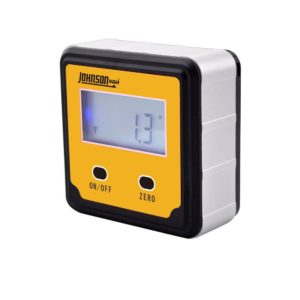Replace an axle shaft yourself
Step-by-step guide to replace an axle shaft yourself
If you want to save money and replace an axle shaftyourself, you’ll need the right tools. Here’s what you need:
• A floor jack and jack stands. Do NOT even think about doing this job  without them.
without them.
• A 3/8” and ½” drive sockets, ratchets and breaker bars
• A long sturdy pry bar. You can rent a tie rod end and ball joint separator tool from the auto parts store.
Do you need an alignment after after you replace an axle shaft?
Depending on the vehicle, you may have to disconnect the strut to remove and replace a CV axle. If the holes in the steering knuckle are elongated, allowing for camber adjustment, you can use a digital angle gauge to measure the angle before disconnecting the strut from the knuckle. They use the gauge to return the camber to the same setting as you put it back together. This isn’t as accurate as a full alignment, so you should take it to a shop for an alignment after doing the job. The digital gauge will get you close enough so you can drive the vehicle to the shop
1) With the vehicle on jack stands, remove the wheel from the vehicle.
2) Reinstall at least two lug nuts onto the wheel studs with the flat side of the nuts touching the rotor. This will keep the rotor in contact with the wheel hub.
3) Attach the angle gauge to the face of the rotor using the angle gauge magnet. Turn on the angle gauge and measure the angle. Write it down. You’ll use this angle measurement to reassemble the axle back to the same angle as you finish the job. Work on one side at a time.
Disassemble brakes and disconnect steering and suspension components
1) Remove the brake caliper. Insert a wire and hang it on the strut spring. 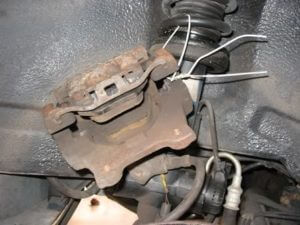 Do not let the brake caliper hang by the brake hose.
Do not let the brake caliper hang by the brake hose.
2) Remove the brake pads and note where they came from so you can put them back in the same place.
3) Loosen the axle nut but don’t remove it yet. Axle nuts are held in place using one of three different methods: staking, cotter pin or “prevailing torque.”
In at staked nut setup, the cv axle shaft has a groove cut into 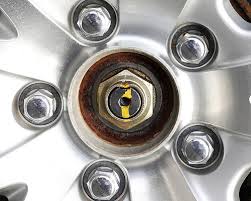 it. Once the nut is torqued to spec, the assembler uses a chisel or pin punch to deform the lip of the nut by forcing it into the groove on the cv axle. That prevents the nut from loosening. This nut should not be reused.
it. Once the nut is torqued to spec, the assembler uses a chisel or pin punch to deform the lip of the nut by forcing it into the groove on the cv axle. That prevents the nut from loosening. This nut should not be reused.
An axle nut that’s held in place with a cotter pin uses 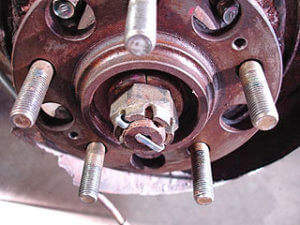 a castle nut with slots. Torque to the recommended torque and then turn the nut to align a slot in the castle nut with a hole in the axle shaft. Insert a new cotter pin and bend the ears around the nut.
a castle nut with slots. Torque to the recommended torque and then turn the nut to align a slot in the castle nut with a hole in the axle shaft. Insert a new cotter pin and bend the ears around the nut.
A prevailing torque nut is deformed at one end. The nut will easily spin onto the threads until it reached the elliptically 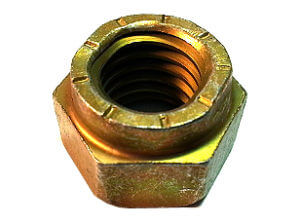 shaped deformation. By continuing to apply torque, the nut if forced into a circle and it’s that force that prevents the nut from loosening. A prevailing torque nut is a one-time use item. Once it’s forced into a circle, it cannot be reused because it has lost its ability to retain torque. If you reuse a prevailing torque nut, it will loosen by itself.
shaped deformation. By continuing to apply torque, the nut if forced into a circle and it’s that force that prevents the nut from loosening. A prevailing torque nut is a one-time use item. Once it’s forced into a circle, it cannot be reused because it has lost its ability to retain torque. If you reuse a prevailing torque nut, it will loosen by itself.
DOs and DON’T for replacing and installing an axle shaft:
• NEVER use your torque wrench as a ratchet to loosen axle nuts. Sure, it gives you leverage, but it also knocks the torque wrench out of alignment.
• NEVER use an impact wrench to loosen an axle nut. The blows can damage the wheel bearing by chipping the chrome plating off the balls or rollers in the bearing.
• Use a long handled ½” drive breaker bar to gain leverage to loosen the axle nut.
• Don’t loosen the axle nut while the vehicle is on the ground with full vehicle weight on the wheel bearing. On many cars, that can damage the wheel bearing.
• The axle nut will require almost 200 ft/lbs of torque to remove and the rotor must be blocked to prevent it from rotating. The easiest way to do that is to insert a hefty screwdriver into the rotor cooling vanes so it wedges against the brake caliper bracket and prevents the rotor from turning as you loosen the axle nut.
4) Remove the brake rotor. On some vehicles you may have to remove the brake caliper bracket in order to remove the brake rotor.
5) On many vehicles you’ll have to disconnect the stabilizer bar end link 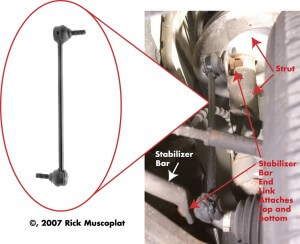 from either the stabilizer bar or the strut, whichever is easier to access. If the threads on the end link are rusted, or the end link is the ball and socket design where the ball spins in the socket while you turn the nut, look for a hex flat on the shaft. If it’s equipped with a hex flat, hold it with an open end wrench. On other styles, the shaft end is designed to be held with a hex wrench. If you can’t remove the end link nut, cut it off with an air powered cut off wheel or a sawzall, or use a nut cracker. In many cases it’s simply easier to cut the shafts and replace the end link with new parts.
from either the stabilizer bar or the strut, whichever is easier to access. If the threads on the end link are rusted, or the end link is the ball and socket design where the ball spins in the socket while you turn the nut, look for a hex flat on the shaft. If it’s equipped with a hex flat, hold it with an open end wrench. On other styles, the shaft end is designed to be held with a hex wrench. If you can’t remove the end link nut, cut it off with an air powered cut off wheel or a sawzall, or use a nut cracker. In many cases it’s simply easier to cut the shafts and replace the end link with new parts.
6) Remove the cotter pin and use a tie rod end separating tool to disconnect 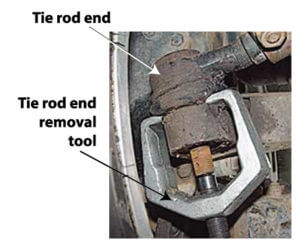 the outer tie rod end from the steering knuckle.
the outer tie rod end from the steering knuckle.
7) Depending on the vehicle and shop manual instructions, it may be necessary to disconnect the lower ball joint. They’re connected in one of two ways: cotter pin and castle nut, or friction clamp and through-bolt. If that’s the instruction in your shop manual, disconnect the fasteners and force the ball joint out of the steering knuckle using your pry bar. Then you can pivot the sheeting knuckle strut outwards (after removing the axle nut) to disconnect the splined portion of the cv axle from the wheel hub.
8) Remove theaxle nut and apply rust penetrant to the splines on the axle shaft. Use a rubber mallet to disengage the axle shaft from the wheel hub. If it’s stuck, screw on the axle nut so it’s flush with the axle threads and tap it with a large mallet to disengage the splines.
9) Remove the outer CV joint and axle shaft from the wheel hub.
10) Pop the inner cv joint out of the transmission. 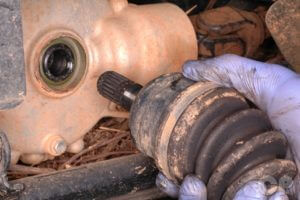 NOTE: on some vehicles, the inner cv joint is held in place with a plate and bolts. Refer to your shop manual for the exact removal instructions.
NOTE: on some vehicles, the inner cv joint is held in place with a plate and bolts. Refer to your shop manual for the exact removal instructions.
If you have trouble prying the inner CV joint out of the transmission, rent a CV joint axle popper like this. Don’t use  this tool as a pry bar; it’s designed to work more like a ball joint separator where you slide it behind the CV joint and strike the end of the tool so it slide behind the cv joint to force it out.
this tool as a pry bar; it’s designed to work more like a ball joint separator where you slide it behind the CV joint and strike the end of the tool so it slide behind the cv joint to force it out.
Axle replacement
The new axle shaft installs in reverse order. But here are some tips to make the axle replacement go a little easier.
• Coat the splined portion of the inner axle shaft with transmission fluid, making sure you lubricate the circlip.
• Apply a light coating of transmission fluid around the smooth portion of the joint that will mate with the transmission seal.
• Insert the inner CV joint into the transmission while aligning the splines. Put it into place until you feel the circlip snap into place. If you can’t get circlip engagement, you can tap the axle shaft with a rubber mallet. Do NOT use a metal maul for this; you can damage the bearings inside the inner cv joint.
• Support the outer cv joint with wire to prevent it from dangling. That can damage the bearings in the inner CV joint and cause it to pop off and disconnect the inner boot.
11) Coat the outer cv joint splines with lubricant and install into the wheel hub.
12) Reinstall the tie rod end and ball joint and tighten to spec.
13) If you had to disconnect the steering knuckle form the strut, reinstall the strut bolts but don’t tighten yet.
Reinstall the rotor and two lug nuts. Attach the angle gauge and move the steering knuckle in or out to reach the noted angle at the start of the procedure. The angle with change as you tighten the strut nuts, so you’ll have to re-adjust as you go.
14) Tighten the axle nut to spec. Jam a screwdriver into the rotor vent vanes to prevent the rotor from turning while you tighten.
How long does it take to replace an axle shaft?
CV axle replacement shop labor usually takes about 1.5 hours per side. If you’ve never done this before or have trouble loosening the axle nut or disconnecting the ball joint or tie rod end, your cv axle replacement job make take much longer. Always work on one side at a time so you have the other side for reference. Cv axle replacement can be a big job for a DIYer, but it’s not a hard job. You just have to use the right tools and follow the steps in order.
©, 2016 Rick Muscoplat
Posted on by Rick Muscoplat
